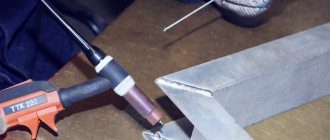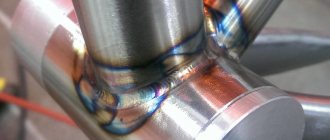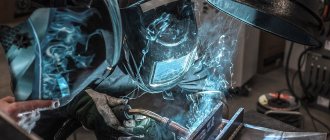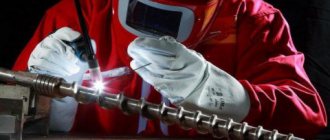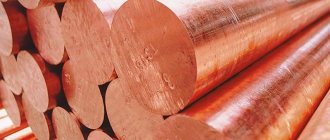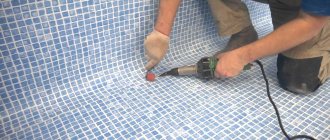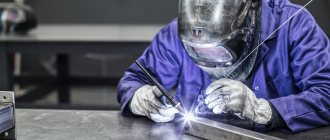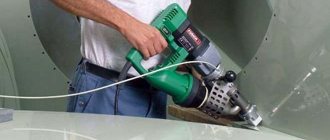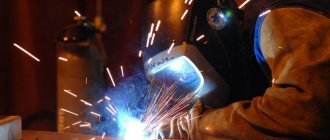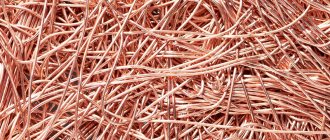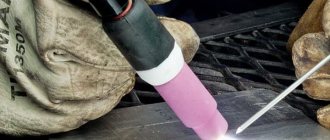Welding copper and alloys based on it requires a special approach due to the low melting point and other characteristics of the metal. There are many options for joining copper blanks. They differ depending on operating conditions and material composition.
- Preparation
- Preparation
- BUDDY TIG 160 from ESAB
Currently, there are several copper welding technologies. They are actively used in various spheres of production and life. Improved technological processes make it possible to eliminate the formation of most defects, including the appearance of pores and cracks. The work is carried out using an inverter familiar to any welder in a protective gas environment; consumables – wire and electrodes.
Copper welding technology
Before working with copper and its alloys, preparation is required. The blanks are cut and adjusted to size with a grinder, using a milling or lathe. If the workpiece has an edge thickness of 6-18 mm, then they must first be prepared. Their cut is made V- or X-shaped. A large number of parts are difficult to prepare manually. It will be justified to purchase a special edger-beveler.
The joints are cleaned of paint, oxides, fats and dirt. To obtain a high-quality welded joint, the work area must be protected from atmospheric air. Sometimes the workpieces need to be preheated. Copper is connected with consumable electrodes using a short arc. The length of the discharge should not exceed 4-5 millimeters. Pulsed arc welding technology is ideal for these purposes. It is performed in a protected environment (usually in argon) and allows you to weld even thin sheets of metal and form a seam in any spatial position, including on the ceiling.
Copper welding methods
Various equipment is used for welding copper blanks - inverters, argon and gas machines, semi-automatic machines. Consumables include consumable and non-consumable electrodes, flux and additives. Arc technology for joining metals is well suited for this work.
To connect thick workpieces with flange thicknesses of 30-35 millimeters, the electroslag method is used. The inverter matches well with carbon electrode. Good results are obtained by welding copper with graphite electrodes.
Material preparation, cleaning
Welding copper with argon can be carried out without thorough surface preparation; it is enough to clean it with an abrasive tool until it shines, and also degrease it. However, cleaning must be done thoroughly.
To weld structures with a thickness of 5-12 mm, it is necessary to cut off one-sided edges, and if more than 12 mm, cut off two-sided edges.
Cleaning before welding
Manual arc welding with electrodes
Arc welding with consumable electrodes has its own advantages and technical and economic advantages, which determined the feasibility of its use. A very important advantage of the method is its high productivity. The second is variability. The point is that manual arc welding is performed under different conditions - with a manual machine, semi-automatic; in a protective environment and submerged.
Preparatory work
If the thickness of the shelves is 6-12 mm, then it is preferable to perform a V-shaped cutting of the edges. The opening angle should be 60-70 degrees. In a situation where it is planned to form a weld seam on the outside, the angle can be reduced to 50 degrees.
The welding sheets should first be positioned at an angle relative to each other. The angle should be approximately 2.5% of the joint length.
Otherwise, it is recommended to grab the workpieces with short stitches (up to 30 millimeters) along the entire length at equal intervals. Tacks should be made with electrodes of smaller diameter, and a gap of 2-4 mm wide should be left between the sheets. If you weld sheets end to end, there is a high probability of overheating of the metal, which will inevitably lead to the formation of hot cracks.
When making tacks, the welder must clearly understand that repeated heating provokes the appearance of cracks in the metal. Therefore, when forming the main seam, they pause before tackling, cut out the temporary connection and clean the joint. This precautionary measure avoids the formation of cracks and takes little time.
Metal with a thickness of more than 12 mm should be welded after X-shaped cutting of the edges. Naturally, you will have to weld the joint on both sides. The tacks are made from the reverse side and cleaned before forming a permanent seam. In exceptional situations, when it is not possible to make an X-shaped cut, a V-shaped cut is performed. The disadvantage of this solution is that it increases the consumption of electrodes (by about one and a half times) and the time it takes to complete the work.
Welding of parts without preliminary preparation of edges or with a V-shaped groove is done on linings. They are pressed tightly against the joint. If this cannot be done, then a cushion of flux is poured underneath. It is recommended to preheat the edges to a temperature of 300-400 degrees Celsius.
Electrodes
For manual arc welding of copper, coated electrodes are used, since uncoated ones lead to the appearance of defects and oxidation of the seam; and their combustion is unstable. Most often, consumable rods are made from copper wire alloyed with manganese or silicon.
Such electrodes have a deoxidizing effect. The coating is selected with such a composition as to ensure stable arc combustion and slag formation. As a result, the seam is well formed and the quality of the welded joint is high.
Modes
To perform the work, a connection to a DC source with reverse polarity is required. Alternating current is used as an exception, since it does not allow for uniform and continuous arc burning. The use of an alternating current source is justified in cases where the protective coating of the consumable contains iron. In such a situation, the current strength increases by 40-50%. It is important for the welder to take into account that alternating current, among other things, contributes to the spattering of the melt. The table below shows approximate welding modes.
| Copper thickness, mm | 2 | 3 | 4 | 5 | 6 | 7-8 | 9-10 |
| Electrode diameter, mm | 2-3 | 3-4 | 4-5 | 5-6 | 5-7 | 6-7 | 6-8 |
| Current strength, A | 100-120 | 120-160 | 160-200 | 240- 300 | 260-340 | 380-400 | 300-420 |
| Operating voltage, V | 25-27 | 25-27 | 25-27 | 25-27 | 26-28 | 26-28 | 28-30 |
Productivity is 15-18 meters of weld per hour of work. To increase productivity, you need to use bronze electrodes. Since copper alloy has a lower melting point, it takes less time to form a weld.
When working with workpieces with a thickness of more than 10 millimeters and a consumable diameter of 6-8 mm, you need to increase the current to 500 amperes. T-bar blanks are connected in the same way as butt blanks. The seam is formed using the boat method.
Execution technique
Parts with thick edges are welded in several passes. Each laid layer is cleaned before the next one is formed. It is advisable to join thin and medium-thick workpieces in one pass. The operation is performed in a reverse step manner. The length of individual sections is 20-30 cm.
The joint is divided into two unequal sections: one 2/3 of the total length and the other 1/3. The longer section is welded first towards the shorter one. After this comes the turn of a short segment. This technique significantly reduces the likelihood of cracks forming in the connection.
Welding work is performed in the lower position with an angle forward, that is, the rod is tilted 15-20 degrees in the direction opposite to welding. If the optimal gap between the edges is not maintained, then there is a high probability of swelling. Then the seam must be trimmed periodically with a hammer. Therefore, you cannot use graphite pads (they will crack), but it is better to use steel or copper ones.
Quality
By means of manual arc welding, high-quality connections are formed. Forging a joint improves its strength by about 10-20%. The other side of the coin: after forging, ductility decreases.
Welding copper pipes
Electrodes "Komsomolets-100" are suitable for work. The process is performed in reverse polarity with connection to a direct current source. The welding current density is 50A/mm.
The working area must first be heated to a temperature of 250-300 degrees Celsius. Pipes with a diameter of up to 50 mm are heated completely, and in the case of connecting mains with a larger diameter, they are limited to local heating. Pre-pot holders are made. As the main seam progresses, the tacks are removed, since repeated heating leads to an increase in the number of pores. Standard labor productivity for such work is 15 meters of seam per hour of work. It is necessary to avoid overheating the metal above 350 degrees Celsius.
Selection of filler materials
Filler materials used for welding copper parts must be selected based on data on the physical and chemical properties of copper or its alloys from which the parts or products are made.
When welding, you should pay attention to the brand of copper or alloy itself - it must be deoxidized or oxygen-free, since, otherwise, during the welding process the metal will boil in the weld pool, as a result of which the weld will be porous and fragile.
As a rod or wire, you should use materials that will avoid boiling of the material in the weld: you need to select a wire or rod that contains chemical elements in the alloy that allow you to displace oxygen from the weld pool area.
Approximate cost of copper wire on Yandex.market
The only non-consumable electrode is tungsten, at the end of which there should be a conical sharpening with a slight bluntness. This form will ensure stable burning of the arc during the welding process itself, which will make it possible to maintain the temperature level of the welding zone and will not allow the parts to quickly cool down until the weld is completed.
Manual welding with graphite or carbon electrode
This method is used to connect low-critical products. Carbon electrodes are used when working with copper up to 15 mm thick. Workpieces with thicker walls are welded with graphite consumables. Each option requires a connection to a direct current source of straight polarity. The current density varies in the range of 200-400A per square centimeter.
The additive is not immersed in the melt, but is kept at a distance of 5-7 mm at an angle of 30 degrees. The electrode is tilted slightly: the angle is approximately 75-85 degrees. The weld is protected from oxidation using a flux consisting of fused borax (96%) and magnesium (4%). Flux, previously soaked in liquid glass, is applied to the edge of the electrode.
If the metal thickness is more than 5 mm, preliminary cutting of the edges is required. The overall angle is 70-90 degrees. The workpieces are placed with a gap of up to 0.5 mm. A graphite or asbestos plate can serve as a lining. The electrode is guided at an angle forward. Workpieces up to 5 mm thick are forged without heating, and parts with thicker walls are preheated to a temperature of 800 degrees, after which they are quickly cooled. It is advisable to weld in one pass, as this ensures the best performance of the joint.
Manual arc welding with argon
Copper bonding in a shielding gas environment is performed using tungsten electrodes when directly connected to a DC power source. Metal with a thickness of over 4 millimeters is preheated to a temperature of 800 degrees Celsius. For the additive, a rod made of copper, bronze or copper-nickel alloy is used.
For metal thicknesses over 6 mm, a V-shaped cutting of edges with an opening angle of up to 70 degrees is recommended. Welding of parts is performed at an angle forward, the rod is held at an angle of 80-90 relative to the workpiece, and the filler material is held at an angle of 10-15 degrees.
Automatic and semi-automatic submerged arc welding
To increase productivity and improve the quality of welded joints, automatic and semi-automatic welding machines are used in industrial production. The connection of parts made of copper of small thickness is successfully performed under submerged arc with non-consumable electrodes.
Preparation
The edges are cleaned, and the workpieces are located at a distance of 1-1.5 millimeters. If the thickness of the shelves exceeds 6-8 mm, then preliminary V-shaped cutting of the edges is recommended, with a total angle of 60 degrees. In this case, the parts can be placed end-to-end, without any technological gap.
When planning to weld workpieces with a gap, you need to take care of the presence of a backing. Otherwise the melt will leak out. It is best to use flux pads, but do not press them too hard onto the workpieces. Indeed, in this case, the quality of the weld root deteriorates.
It is advisable to weld copper parts with preheating of the work area. If the shelves are of small thickness, then you can limit yourself to local heating. Thick walls must be heated throughout the welding process. The same should be done when working with long joints. The heating temperature is 250-300 degrees Celsius.
Additive
Copper wire is used for welding. Thin wire must first be hardened. If this is impossible to do for some reason, then it is advisable to replace the thin copper wire with a thicker bronze one. It should be borne in mind that the use of bronze increases the likelihood of cracks.
Automatic welding of workpieces with an additive made of thin copper wire involves the use of special broaching mechanisms to automate the supply of material to the working area. In addition to thin wire, you can use wire 3 or more millimeters thick. Wire thicker than 5 mm is not used for welding copper, since in this case special current sources are required.
Fluxes, fused and unfused
Among the fused fluxes, the most widely used are:
- manganese high-silicon - AN-348, AN348A, OSTS-45;
- manganese low-silicon - PN-10, AN-51;
- manganese-free low-silicon – AN-20.
No less popular are ceramic fluxes, which allow you to alloy the melt and add deoxidizing agents to its composition. The composition of the most popular brands of such fluxes is given in the table.
| Components | Flux brand | |
| K-13 | ZhM-1 | |
| Alumina | 20 | — |
| Quartz sand | 8-10 | — |
| Magnesite | 15 | — |
| Chalk | 15 | — |
| Borax anhydrous | 20 | — |
| Fluorspar | 15-19 | 8 |
| Aluminum powder | 3-3,5 | 0,8 |
| Boron spar | — | 3,5 |
| Marble | — | 28 |
| Feldspar | — | 57,5 |
| Charcoal | — | 2,2 |
The main advantage of ceramic fluxes is that they allow you to work with alternating current sources. The most active flux is the ZhM-1 brand. It provides consistent results. When using it, the melt content is as pure as possible. The research results are shown in the table.
| Metal | Content of components, % | |||||
| Cu | Fe | Al | Si | MP | Others | |
| Basic | 99,76 | 0,016 | 0,008 | Footprints | — | 0,2 |
| Electrode wire M2 | 99,68 | 0,016 | 0,006 | Footprints | — | 0,3 |
| Shva | 99,92 | 0,048 | 0,004 | 0,009 | Footprints | 0,02 |
Modes
Most often, copper is welded with direct current with reverse polarity under submerged arc. The only exception is the option using ZhM-1 flux, which requires alternating current. Recommended welding modes are shown in the table.
Fused flux welding modes
| Copper thickness, mm | Edge preparation | Wire grade | Wire diameter, mm | Current strength, A | Wire feed speed, m/h | Welding speed, m/h |
| 2 | No | M1,M2,M3 | 1,4 | 140-160 | 120 | 25 |
| 3 | No | M1,M2,M3 | 2 | 190-210 | 140 | 20 |
| 4 | No | M1,M2,M3 | 2 | 250-280 | 170 | 20 |
| 5 | No | M1,M2,M3 | 2 | 310-320 | 210 | 20 |
| 6 | No | M1,M2,M3 | 2 | 330-340 | 220 | 20 |
| 4 | No | M1,M2,M3 | 3 | 370-390 | 150 | 38-42 |
| 5 | No | M1,M2,M3 | 3 | 380-400 | 160 | 30-35 |
| 6 | No | M1,M2,M3 | 3 | 460-470 | 175 | 30-35 |
| 81 | V-60°, blunting | M1,M2,M3 | 3 | 360-380 | 150 | 20 |
| 82 | V-60°, blunting | M1,M2,M3 | 3 | 390-410 | 160 | 20 |
| 101 | V-60°, blunting | M1,M2,M3 | 3 | 470-490 | 200 | 20 |
| 102 | V-60°, blunting | M1,M2,M3 | 3 | 540-560 | 220 | 20 |
| 121 | V-60°, blunting | M1,M2,M3 | 3 | 510-530 | 200 | 20 |
| 122 | V-60°, blunting | M1,M2,M3 | 3 | 580-600 | 240 | 20 |
| 122 | V-60°, blunting | M1,M2,M3 | 4 | 500-510 | 120 | 20 |
| 122 | V-60°, blunting | M1,M2,M3 | 4 | 570-580 | 140 | 20 |
| 14 | V-60°, blunting | M1,M2,M3 | 4 | 530-540 | 130 | 20 |
| 12 | V-60°, blunting | M1,M2,M3 | 4 | 600-610 | 150 | 20 |
| 16 | V-60°, blunting | M1,M2,M3 | 4 | 570-580 | 140 | 20 |
| 16 | V-60°, blunting | M1,M2,M3 | 4 | 650 | 160 | 20 |
| 3 | No | BrKMts3-1 | 2 | 340-350 | 250 | 70-75 |
| 4 | No | BrKMts3-1 | 2 | 350-370 | 260 | 60-70 |
| 5 | No | BrKMts3-1 | 2 | 380-420 | 270 | 45-55 |
| 6 | No | BrKMts3-1 | 2 | 450-470 | 300 | 26-32 |
| Note. Index values: 1 - first layer; 2 - second layer. | ||||||
Welding modes under ceramic flux ZhM-1
| Copper thickness, mm | Wire diameter, mm | Current strength, A | Operating voltage, V | Welding speed, m/h |
| 4 | 4 5 | 490 550 | 22-24 22-24 | 42 37 |
| 6 | 4 5 | 580 640 | 26-28 26-28 | 32 28 |
| 8 | 4 5 | 650 710 | 30-32 30-32 | 26 22 |
| 10 | 4 5 | 710 780 | 34-36 34-36 | 22 18 |
Welding modes using ceramic fluxes K-13
| Copper thickness, mm | Wire diameter, mm | Operating voltage, V | Current strength, A | Welding speed, m/h |
| 2 | 2 | 26-27 | 160-180 | 21 |
| 5-6 | 2-3 | 28-30 | 400-450 | 21 |
| 7-8 | 3 | 35-45 | 550 | 18 |
Modes of automatic submerged arc welding of copper lap joints
| Flux brand | Sheet thickness, mm | Operating voltage, V | Current strength, A | Welding speed, m/h | Wire feed speed, m/h | Character of the current |
| AN-348A | 3 | 30-35 | 220-240 | 25 | 170 | Constant |
| AN-348A | 4,5 | 30-35 | 300-340 | 25 | 230 | Constant |
| ZhM-1 | 4 | 30 | 400-450 | 32 | 81 | Variable |
| ZhM-1 | 6 | 30 | 500-525 | 25 | 87 | Variable |
| ZhM-1 | 8 | 30 | 600-625 | 23 | 95 | Variable |
| ZhM-1 | 10 | 30 | 775-800 | 18 | 103 | Variable |
| K-13 | 6 | 30 | 400-450 | Constant |
Technique
The methods for joining steel and copper have minor differences. It is advisable to connect shelves up to 8 mm thick in one pass. When working with thick workpieces that require several passes to weld, each seam must be thoroughly cleaned before applying a new one.
In automatic and semi-automatic welding, thin copper filler wire is used. Parts with walls thicker than 6 mm are pre-cut with a total opening angle of 90 degrees. To reduce the number of pores, parts are welded without transverse oscillatory movements.
For semi-automatic welding of workpieces with walls 10+ mm thick, 2 mm thick wire is used. It is advisable to complete the work in one pass. Recommended settings: voltage – 30V; current – 300A; productivity – 10 meters per hour. It is necessary to ensure oscillatory movements of the holder in the transverse direction.
Multi-pass welding requires the specialist to be attentive and accurate. To get rid of slag in the melt, you need to follow the order in which the beads are deposited. After forming the root weld, the beads are fused on the sides. The procedure for performing the work is shown in the figure.
Quality
The strength of the welded joint largely depends on the welding mode and consumables. The table shows average data for various connections performed at optimal conditions.
| Flux brand | Electrode wire grade | Mechanical strength | |||
| welded joint, MPa | weld metal, MPa | Bend angle, degrees | relative seam elongation | ||
| ZhM-1 | M2 | 177,5 | 180,4 | 180 | 41,4 |
| OSC-45 | M2 | 168,7 | 174,5 | 180 | 26,3 |
| K-13 | M1 | 258,9 | — | — | 43 (13)* |
| AN-26 | M3 | 207,9 | 203,0 | 180 | 33,8 |
| AN-348A | M1 | 192,2 | 178,5 | 180 | 41,6 |
| AN-348A | BrKMts3-1 | 234,4 | 307,9 | 180 | 33,0 |
| Note: Strength of the base metal 213.8 MPa *Test results for flat samples are given in parentheses | |||||
According to the data given in the table, we can conclude that the strength of the welded joints is not inferior to the base metal.
Welding with a gas torch
Sheets up to 10 mm thick are welded with a flame with a power of 150 liters per hour of work per 1 mm of metal. Do not cook with a carburizing flame. This is fraught with the formation of cracking in the weld. The work is carried out in one pass, since reheating a previously formed seam will cause cracks to appear.
Preparation
The workpieces must be cleaned of dirt, stains, oxides, etc. The lengthwise width of the clean area is 30 cm on each side of the joint. You can clean it manually, or you can use special equipment equipped with abrasive working parts.
As practice shows, copper is most often welded end-to-end. Other connection methods - T-joint and overlap - are used much less frequently. In the first case, undercuts occur very often, and in the second, there is a high probability of lack of penetration. Therefore, instead of an overlap connection, the parts are welded end to end.
When it becomes necessary to overlap weld parts, it is important to follow a simple rule. It says that you need to weld the seam along the thick sheet from the thin side. Otherwise, there is a high probability of burning through thin metal. The figure shows two options - correct and incorrect.
Before welding copper with a thickness of 1.5-2 mm, it is necessary to flange the workpieces along the entire length of the joint. Cutting of workpieces with flanges up to 3 mm is not carried out. The parts are butt welded with a gap of 1.5-2 mm. To ensure the best possible penetration, linings with a groove are used. Without cutting, you can weld thicker sheets - up to 8 mm inclusive. But only if it is possible to form seams on both sides. The technological gap when assembling the structure is 3 mm.
Before welding copper sheets with a thickness of 3-10 mm, it is advisable to bevel the edges. The bevel angle is 45 degrees, and the gap between the workpieces is 3 millimeters. If the thickness of the shelves exceeds 10 mm, then a V-shaped cutting of the edges is performed with an opening angle of 90 degrees. Thicker workpieces are joined using two torches simultaneously with the joint positioned vertically.
Filler wire
For the manufacture of low-critical structures, wire is used, the composition of which corresponds to the base metal. But in cases where a high-quality connection is required, it is better to take wire with a deoxidizer. The filler wire intended for welding copper up to 10 mm thick contains phosphorus, and the consumable material for thicker workpieces contains silicon.
It is not recommended to use tin bronze filler wire. It has a melting point lower than copper by 150 degrees Celsius. Therefore, it will not be possible to ensure good penetration.
As for the choice of diameter, as practice shows, there is no need to take consumables thinner than 1.5 and thicker than 8 mm. The table shows the recommended wire sizes depending on the thickness of the workpieces.
| Wire diameter, mm | Thickness of welded copper parts, mm |
| 1,5 | up to 1.5 |
| 2,0 | 1,5-2,5 |
| 3,0 | 2,5-4,0 |
| 4,0 | 4,0-6,0 |
| 5,0 | 6,0-8,0 |
| 6,0 | 8,0-15,0 |
| 8,0 | over 15 |
Technology
When working with copper sheets whose thickness is 5 mm, it is advisable to install them at an angle of 7-10 degrees relative to the horizon. In this case, the filling of the cutting will be most complete. The burner is moved in the upward direction, holding it at an angle of 40-50 degrees relative to the sheet of metal. The wire is held at an angle of 30-40 degrees to the sheet.
When welding metal with a thickness of 15 millimeters or more, the sheet must be positioned vertically. Work is carried out on both sides simultaneously. That is, two burners are needed. They are held at right angles to the work surface. If the sheet thickness is over 20 mm, then the joint must be welded in the same way, but divided into sections up to 15 cm long. Take short breaks to forge the seams.
When welding is performed with tacks, the main seam must be formed not from the beginning, but by retreating from the edge by about a third of the total length of the joint. It is important to pay attention to the fact that 2/3 are cooked by multi-stage penetration in one direction, while the remaining part is cooked in the opposite direction. This technique is recommended for all methods of welding copper sheets.
Quality
How well the job is done depends not only on the skill of the specialist. Quality is also determined by the welding mode, the composition of the additive and flux, and the type of welded joint.
Copper gas welding is characterized by relatively low productivity. It is very difficult to achieve good quality with a T-joint. Even specialists with extensive experience in performing such operations often experience defects. It is difficult to maintain the optimal temperature of the weld pool. And with the slightest overheating, a large number of pores are formed.
The quality of the weld is improved by forging, but not always. It will be of no use if the sheet thickness is less than 4 millimeters. As a result of forging, the connection becomes brittle and internal stresses are created.
Contact welding of copper
The technology is used everywhere for welding pipes, wire, tapes, and rods. But the method is most in demand for joining copper alloys.
Spot or seam varieties of contact welding are not widely used. Butt joints are also rarely used due to technological difficulties, namely: the need to retain molten metal at the ends of the workpieces. Another disadvantage is that the joints have to be heated to a greater depth, and this ultimately leads to shrinkage of the metal.
The highest quality connection is obtained when the joint is upset under current. Using this method, it is possible to obtain a weld that is not inferior in strength to the base metal. In practice, resistance welding is often used to connect copper wire using a capacitor discharge. Recommended operating modes are given in the table.
Approximate modes of contact butt welding of copper billets of a certain range
| Welding mode parameters | Rod, diameter 10 mm | Pipe 9.5x1.5 mm | Tape 44.5x10 mm |
| Installation length, mm | 20 | 20 | — |
| Melting allowance, mm | 12 | — | — |
| Allowance for draft, mm | 8 | — | — |
| Reflow speed, mm/sec | 8 | — | — |
| Settlement speed, mm/sec | 200 | — | — |
| Specific settling pressure, MPa | 372,2 | 284,4 | 215,7 |
| Specific power, kW/mm2 | 2,6 | 2,66 | 1,35 |
| Welding current, kA | 33 | 20 | 60 |
| Secondary voltage, V | 6 | 5 | 10 |
Approximate modes of butt resistance welding of copper wire using a capacitor discharge
| Wire diameter, mm | Capacitor capacity, µF | Charge voltage, V | Initial distance at the joint, mm | Upsetting force, N |
| 1,6 | 256 | 900 | 14 | 1373 |
| 2,0 | 380 | 1000 | 15 | 1373 |
| 2,8 | 380 | 1400 | 16 | 1471 |
| 3,0 | 440 | 1500 | 16 | 1569 |
| 3,0 | 1200 | 1000 | 9 | 1177 |
| 3,0 | 1200 | 800 | 5 | 1177 |
| 3,0 | 550 | 1400 | 5 | 1471 |
| 3,0 | 540 | 1300 | 8 | 1569 |
| 3,0 | 540 | 1500 | 12 | 1569 |
| 3,2 | 550 | 1500 | 14 | 1765 |
Water pipes
Welding of copper pipes is carried out by various methods, one of the most popular is argon welding.
The sequence of actions is as follows:
- warm up the pipeline joint being connected;
- drip molten metal from the additive, stretching it along the weld line;
- move the burner and repeat, gradually adding metal;
- when sewing a seam without interruption, undercuts and burns often occur;
- if you still get a burn; you need to let it cool and only then brew it.
When working with a pulse inverter, the welding speed increases and the risk of pipe deformation is reduced.
To select the operating current, it is better to take several pieces of pipe cuttings.
Welding copper with an inverter
The equipment is designed to supply direct current with direct or reverse polarity. It is recommended to use the device with short breaks. Small sections up to 4 centimeters long are welded. Afterwards you need to let them cool naturally. Hold the electrode at an angle of 10-20 degrees during operation.
The inverter in combination with carbon electrodes showed good results. To melt them, a temperature three times higher than the melting threshold of copper is required. because of this, their consumption is very small. But to work with such rods you need to have experience. The result is characterized by high oxidation resistance, density, strength and good quality. During work, the electrode is tilted at an angle of 30 degrees relative to the working surface. The current strength is set depending on the thickness of the shelf. It can vary in the range of 35-130 amperes. An inverter in combination with carbon electrodes is most often used for welding strands and wires.
Advantages
Repair, connection, and creation of products using argon welding are significantly different from other methods. The advantages of this method are the following:
- more than favorable price;
- ensuring a several-fold increase in the service life of the part;
- are not afraid of oxidation and nitriding;
- Splashing of the material during the cooking process is avoided;
- high speed of work.
The workshop’s specialists will perform work of any complexity, regardless of the purpose of the products, their quantity, or difficulties. The seam is given strength, durability, and 100% integrity.
Copper welding machines
Various welding machines are used to connect copper: inverters, automatic, semi-automatic, TIG. The most popular brands are ESAB, SPETSELECTROMASH, TESLA.
BUDDY TIG 160 from ESAB
The burner is switched on in two- and four-contact modes. The device is compatible with any generators. In addition to copper, it is used for welding other metals, including stainless steel.
RENEGADE ES 300i ESAB
Equipped with built-in memory that stores several sets of settings. Independently adjusts the starting parameters depending on the current strength. The device is small and light in appearance and packs a lot of power. Inverters are used for welding rods. They generate current in the range of 60-110 amperes. Works great with copper and carbon electrodes.
For welding with electrodes
Most suitable for joining copper plates. As an example, the Orion 150s or 250s is lightweight and has sufficient power. Reliably welds copper with tungsten electrodes in a protective environment (most often argon).
The Resanta SAI-220 inverter can be connected to a 140-220 volt network. The device is equipped with a forced cooling system, so it does not overheat. Convenient option for field work.
For wire welding
Copper wire welding is performed using an Energomash SA-97PA20 inverter semi-automatic machine. Its weight is 13 kilograms and makes it possible to work with wires with a thickness of 0.6 to 0.9 millimeters.
The Shyuan MIG/MMA-290 model smoothly supplies consumables to the work area. The feed speed can be adjusted from 2.5 to 13 meters per minute. Can work with electrodes.
The inverter semi-automatic Soyuz SAS-97PA195 is equipped with a 60V idle speed function. The operating voltage is adjustable in the range from 15 to 23 volts. A wire of 0.8-1 mm is suitable for work. The device is convenient, reliable and weighs only 10 kg.
Radiator soldering
To solder a copper radiator you will need:
- propane tank;
- burner with reducer and hose;
- massive copper soldering iron;
- soldering acid;
- copper-phosphorus solder.
The detected leak area should be thoroughly cleaned and degreased. Next, it is heated with a torch, the surface is moistened with acid with a brush, and a little solder is picked up with a heated soldering iron. The solder is smoothed over the repair area.
A hair dryer is also used to warm up the surface..
